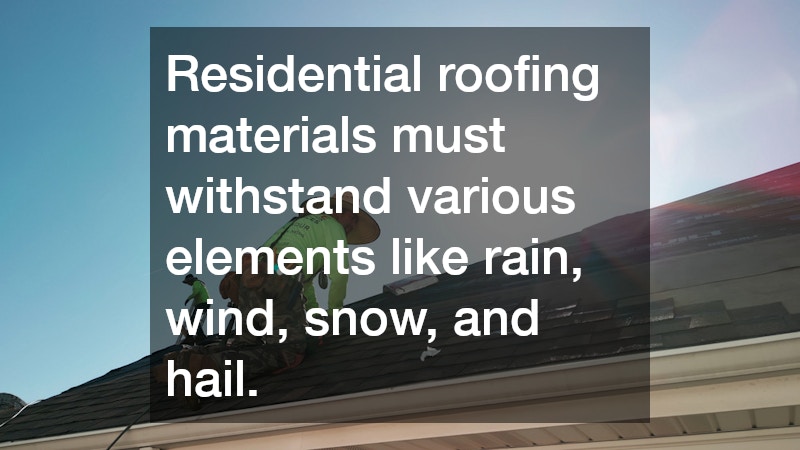What Material Should You Choose for Your Homes Roof?
When it comes to residential roofing, choosing the right material is a crucial decision that impacts not only the aesthetic of your home but also its durability and energy efficiency. Homeowners face a plethora of options, each offering unique benefits and challenges. Understanding the properties of different roofing materials can significantly influence the longevity and performance of your roof.
Residential roofing materials must withstand various elements like rain, wind, snow, and hail. While aesthetics plays an essential role in the selection process, functionality, cost, and local climate concerns also require serious consideration. Often, the ideal choice is a material that balances these factors effectively, providing a durable yet visually pleasing cover for your home.
This article aims to guide homeowners through the available choices for residential roofing materials. We’ll explore the most common types, their unique features, and the implications of each material in terms of maintenance and cost-effectiveness. By understanding these factors, you are better equipped to make an informed decision that aligns with your budget and preferences.
Asphalt Shingles
Asphalt shingles are perhaps the most popular choice for residential roofing in the United States. Known for their affordability and ease of installation, these shingles are a favorite among budget-conscious homeowners. Asphalt shingles come in a variety of colors and styles, providing versatility and choice to complement the architecture of any home.
Beyond aesthetics, asphalt shingles provide reliable water resistance and a moderate lifespan, typically ranging from 15 to 30 years. While they lack the longevity of some more expensive materials, they offer a good balance between cost and performance, making them an excellent choice for many homes. Moreover, advancements in manufacturing have led to the creation of asphalt shingles that mimic the look of more expensive materials, like slate or wood, at a fraction of the cost.
However, asphalt shingles have limitations, particularly in extreme weather conditions. Heavy winds, for instance, can lift and damage them, while excessive heat might cause them to warp or crack. Despite these drawbacks, their ease of repair and replacement often keeps them at the top of many homeowners’ lists when considering residential roofing options.
Metal Roofing
Metal roofing has gained popularity in recent years due to its durability, energy efficiency, and modern look. Available in materials such as aluminum, copper, and steel, metal roofs offer a long lifespan, often exceeding 50 years, making them a long-term investment for your home. They reflect solar radiant heat, which can reduce cooling costs significantly during warmer months, making them an energy-efficient choice.
Unlike asphalt shingles, metal roofs are exceptionally resistant to weather phenomena, including heavy winds, hail, and even wildfire, making them ideal for homes in areas prone to these conditions. They can also handle extreme temperatures without deteriorating, providing peace of mind for homeowners in diverse climates. However, it’s essential to choose a reputable installer to ensure correct installation since improper fitting can lead to water leaks or reduced energy efficiency.
One potential downside of metal roofing is its initial cost, as it tends to be higher than that of traditional shingle options. This upfront expenditure is often mitigated by its longevity and energy savings. Additionally, modern metal roofs come in a spectrum of colors and finishes, including designs that mimic the appearance of other materials, allowing flexibility in achieving the desired aesthetic for your residential roofing.
Tile Roofing
Tile roofing, commonly made from clay or concrete, offers one of the most distinctive and stylish appearances available for homes. Known for their durability and longevity, tiles can last over 100 years with proper maintenance, making them an investment that spans generations. They are highly resistant to weather damage, insects, and rot and are generally low maintenance once installed.
Beyond durability, tile roofing provides excellent insulation, contributing to energy efficiency by keeping homes cooler in hot climates. Their heavy weight helps stabilize homes against high winds, which can be a crucial factor in certain geographic areas. Installing tile roofs requires professional expertise due to their weight and the need for additional structural support, which can increase the cost of the initial installation.
The upfront cost of tile roofing and the need for a reinforced roof structure can be deterrents for some homeowners. However, the low long-term costs due to minimal repair needs and energy savings often justify the initial investment. Additionally, tiles are available in an array of styles and colors, allowing homeowners to customize their home’s look while maintaining the advantages of durability and energy efficiency.
In choosing the best material for your home’s roof, consider the climate, budget, and aesthetic preferences. Each material offers distinct advantages; asphalt shingles provide affordability and ease, metal roofs offer longevity and energy efficiency, and tile roofing brings durability and a unique visual appeal. Carefully evaluating these factors can help ensure you select a residential roofing material that meets your needs.
While asphalt shingles are perfect for those prioritizing budget without sacrificing aesthetic options, metal roofs provide a sustainable solution for energy-conscious homeowners. Tile roofing, with its long lifespan and traditional appeal, represents an excellent choice for those looking for timeless elegance and durability. With proper research and consideration, you can find a new roof that enhances your home’s beauty and functionality.
Investing in the right roofing material is crucial since the roof is not just the home’s cover but a protector of its interior and inhabitants. Engage a professional to ensure the installation is done correctly and consult them to understand better which materials suit your area’s specific needs. Taking the time to choose wisely will result in a roof that stands the test of time, providing safety and comfort for years to come.

